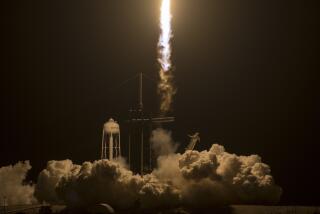With Repairs on Agenda, Mir May Yet Be Back to Normal
- Share via
MOSCOW — After limping along its cosmic trails on half-power for more than three months, Russia’s space station could soon be restored to full working order. A cargo capsule blasted off for Mir on Sunday, and officials ordered an Oct. 20 spacewalk to make repairs.
The unmanned Progress supply ferry that rocketed out of the Baikonur Cosmodrome in Central Asia will deliver the last of the tools and materials needed to fix the damage inflicted on Mir’s Spektr research module during a June 25 accident.
Mir and the cargo ship are expected to link up Tuesday.
The U.S. space shuttle Atlantis, which just concluded a six-day mission with Mir, already has delivered most of the repair kit and managed to stabilize the wobbly Russian space lab by installing a new navigational computer to replace one with a troubling track record of failures.
Mir has been plagued by malfunctions and chronic power shortages since the June accident, in which another unmanned cargo ship crashed into Spektr during a remote-controlled docking practice that went awry. One of Mir’s 10 solar energy panels was knocked askew by the wayward capsule, and power from three others was lost when the U.S. and Russian crewmen had to sever cables to seal off the research module.
In an Aug. 22 spacewalk by the two Russian cosmonauts now aboard Mir, commander Anatoly Solovev and flight engineer Pavel Vinogradov, the pair managed to replace the cut battery cables and recover much of the lost power. But a second spacewalk Sept. 6 by Solovev and NASA astronaut Michael Foale failed to locate the punctures in Spektr’s hull.
When Atlantis separated from Mir on Friday and flew around the station on a departing inspection tour, the Mir crewmen pumped air into the sealed-off Spektr in hopes that the oxygen would be visible as it escaped through the punctures into the vacuum of space.
The space station and its modules are covered with insulation padding, and that “blanket” had obscured the tiny punctures caused by the crash.
Friday’s air-pumping experiment “fully confirmed Russian experts’ predictions about the location of the ruptures,” Viktor Blagov, deputy flight director for Mission Control, told reporters Sunday. Blagov noted that two leaks were detected where the supportive struts of the damaged solar array are attached to Spektr.
A videotape made by the Atlantis crew will be examined after the shuttle’s return to Earth, which was delayed at least until today by bad weather in Florida. However, the Russian Space Agency was confident enough of having located the areas of damage to set the Oct. 20 date for Mir’s crewmen to don their pressurized suits and patch the holes on Spektr.
More to Read
Sign up for Essential California
The most important California stories and recommendations in your inbox every morning.
You may occasionally receive promotional content from the Los Angeles Times.











